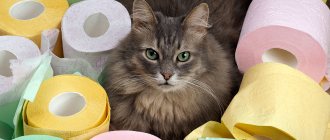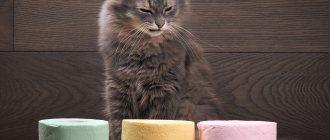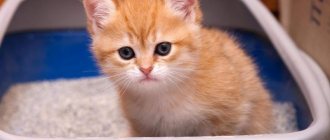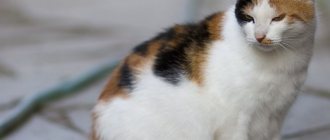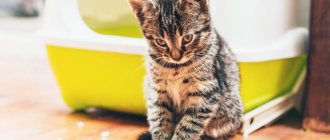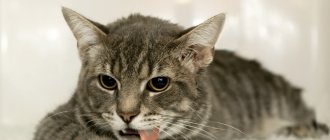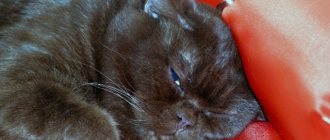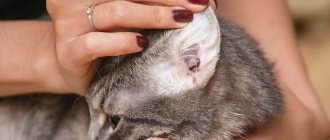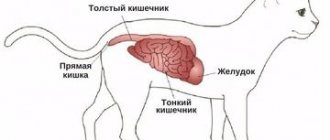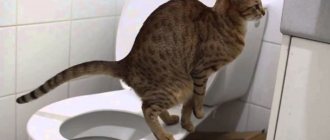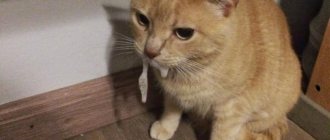Perhaps every more or less experienced breeder has encountered diarrhea in their pets. As a rule, digestive disorders are associated with poor-quality food or similar reasons, and therefore owners rarely start to worry. Pets go to the veterinarian if something greatly confuses the breeder or seems extremely unusual. Such “unusualities” include yellow diarrhea in a cat. What can cause it, and how dangerous is such a phenomenon for the health and life of the animal?
Adverse symptoms of diarrhea in cats
Normal cat stool is brown. With diarrhea, the frequency of bowel movements, color, consistency and smell of the discharge changes. Using these indicators, the localization of the disease can be determined.
Frequency
Defecation several times an hour in small portions, with straining, suggests inflammation of the colon (colitis);
- Yellow or greenish diarrhea indicates rapid passage; the cause may be damage to the small intestine.
- Black, tar-like stool indicates bleeding in the upper digestive system.
- Bloody stools (or streaks) indicate bleeding in the large intestine.
- A light, dough-like appearance indicates liver disease.
- Gray discharge with a rancid odor indicates impaired digestion or absorption of food.
Consistency
- A large volume of soft stool indicates overeating or too much fiber in the food.
- Watery stools indicate irritation of the walls of the small intestine with toxins or infection (for example, acute enteritis).
- Foamy bowel movements suggest a bacterial infection.
- Fatty stools suggest malabsorption and damage to the pancreas (malabsorption).
The more watery the stool, the more unpleasant the odor:
- The smell of sour milk or rancid food occurs when an animal is overfed.
- The smell of rot is usually accompanied by infections, such as panleukopenia.
Duration of diarrhea
A single unformed stool caused by overfeeding does not require treatment, but a starvation diet for 24 hours and a reduction in food portions subsequently.
Diarrhea that lasts more than a day requires emergency veterinary attention, as it causes a large loss of moisture and dehydration of the body.
In addition to stomach upset, diarrhea in cats may be accompanied by other side symptoms that should alert owners of furry cats. The cat may refuse food or treats offered. General activity decreases, the pet refuses to participate in outdoor games, experiences pain and discomfort during defecation.
• increase in general temperature; • weakness, apathy, depression; • increased thirst; • loss of body weight; • pallor of the mucous membranes; • deterioration of the coat; • lack of appetite.
Chronic diarrhea can cause dehydration and severe intoxication. Kittens lag behind in growth and development, quickly lose weight, metabolic processes and water-salt balance in the body are disrupted.
How can the color of stool change during diarrhea?
Information about the color of stool and its structure will help the doctor when making a diagnosis. Types of diarrhea:
- Watery stools of normal color occur with a sudden change in diet, and also occur due to stress. If bowel movements occur 2-3 times, there is no reason to worry.
- Yellow stool indicates that food is poorly digested. Orange color of feces indicates problems with the liver or gall bladder. If yellow diarrhea occurs in a kitten not for the first time, it is advisable to diagnose the internal organs.
- Green liquid feces are a sign of dysbiosis and putrefactive processes in the intestines.
- Black diarrhea indicates internal bleeding in the upper digestive tract.
- White diarrhea is a sign of gallbladder dysfunction. Discolored stool indicates that little bile is being produced.
- Diarrhea with mucus and blood. A large amount of mucus in feces occurs with helminthiasis. Bloody inclusions in the stool appear due to inflammation of the intestinal mucosa, as well as due to damage to its walls by a foreign body. Bacterial and viral infections also cause bloody diarrhea.
Form
The shape of your stool can also tell you a lot about your internal health. Thin stool (resembling a pencil) should alert you. Perhaps some kind of obstruction is blocking the passage in the lower part of the intestine or there is pressure from the outside on the colon. This could be some kind of neoplasm. In this case, it is necessary to perform a colonoscopy to exclude a diagnosis such as cancer.
Hard and small feces indicate the presence of constipation. The cause may be an inadequate diet that excludes fiber. You need to eat foods high in fiber, do physical exercise, take flaxseed or psyllium husk - all this helps improve intestinal motility and ease stools.
Stool that is too soft and clings to the toilet contains too much oil. This indicates that the body does not absorb it well. You may even notice oil droplets floating. In this case, it is necessary to check the condition of the pancreas.
In small doses, mucus in the stool is normal. But if there is too much of it, it may indicate the presence of ulcerative colitis or Crohn's disease.
General information
Diarrhea, or diarrhea, is nothing more than an upset stomach, the main symptom of which is loose stools. A healthy animal's stool is usually well-formed, dark brown in color, and slightly soft and moist. Normally, a cat should go to the toilet 1-2 times a day.
Diarrhea may be accompanied by vomiting, nausea, and your pet may lose its appetite. Often the cat suffers from abdominal pain and experiences severe stress. If measures are not taken in time and treatment of the animal is not started, dehydration will occur in its body, which can even lead to death.
Reasons for changes in stool
Changes in the color and consistency of feces in a kitten or adult cat are often associated with errors in nutrition. When eating unsuitable food, the load on the digestive organs increases. The stomach does not completely digest food, and the intestines cannot fully absorb it. The result is unformed feces in which mucous particles can be found.
Other common causes
Intestinal dysfunction can lead to a change in the color of stool, as a result of which food stagnates in the intestines.
But in addition to poor-quality food, the following diseases and disorders can affect the consistency of excrement:
- Intestinal dysfunction. Insufficient secretion of digestive juices and weak peristalsis contribute to stagnation and fermentation of eaten food in the body. Soon, pathogenic microflora begins to actively multiply, causing increased gas formation and flatulence. The cat's feces turn out to be green.
- Insufficient enzymatic activity of the pancreas. The consequence of this disorder is poor digestion of food, resulting in yellow feces remaining in the tray.
- Hepatitis. As the disease progresses, the functioning of not only the liver, but also the gallbladder is disrupted. As a result, the cat's feces become discolored, but the urine becomes dark brown.
- Internal hemorrhage. If the cat passed liquid black feces onto the tray, this means that bleeding has occurred in the stomach, or more precisely, in the upper section. When bright red blood is present in the stool, this indicates that damage has occurred in the intestine itself.
Orange dry feces often appear in pets when they eat food colored with dyes. If the stool is not soft, but hard, like a goat's, this means that the animal's diet does not have enough fluid. In this case, it is enough to adjust the menu and change the brand of food. If, even after changing the diet, the cat poops liquid or too dry, it is better not to hesitate to visit the veterinarian.
How often does a kitten defecate?
Normal bowel movements in a kitten depend on a number of factors. The most important is age. Gender and health indicators are equally important.
Table: number of bowel movements during the day
| Age | Urination | Defecation |
| From 1 to 21 weeks | until 3 | from 3 to 4 |
| From 3 to 6 months | from 6 to 10 | from 2 to 3 |
| From 6 months and older | up to 5 | from 1 to 2 |
There is a difference between males and females. Cats often go to the litter box in small sizes. This is due to the physiological structure of the urinary tract; they are narrower and longer than those of females.
The number of trips to the toilet may increase significantly if the kitten eats food with a high fiber content.
When does a kitten start going to the toilet on its own?
In the first three weeks after birth, the cat takes care of the kitten's toilet. From the outside it may seem that newborn kittens do not defecate at all. The mother monitors the hygiene of her cubs and licks off any secretions, cleaning out impurities. The cat massages with its tongue, stimulating the digestion process of newborn kittens. This helps them pass stool. In addition, gas formation in the small belly is reduced.
In the first weeks of life, the baby's toilet is monitored by the mother cat.
If kittens are left without a mother for some reason, they cannot go to the toilet on their own, which is why they can die. When kids find themselves in such a situation, they definitely need help. A regular cotton swab dipped in warm water is suitable for this. They are given a light abdominal massage. It is important not to press, but simply move the tampon in different directions.
Video: how to help a kitten go to the toilet
As soon as the baby turns one month old, his digestive organs are already sufficiently formed and populated with beneficial microflora. The kitten's nutrition is still based on mother's milk, but it already requires complementary feeding. These can be liquid porridges, meat purees, fermented milk products. The food chosen for complementary feeding should not cause injury to the kitten’s gastrointestinal tract.
Video: kitten's first feeding
During this period, the kitten begins to go to the toilet on its own. The frequency of bowel movements ranges from 3 to 6 times per day. A healthy kitten's stool is thick and soft. There should be no impurities of liquid or mucus.
At the age of one month, the baby is not yet accustomed to the tray, so it is quite difficult for the owner to calculate how many times he defecated. It is necessary to monitor the condition of the kitten as a whole. There is no reason to worry only if the baby is cheerful and cheerful, his stomach is soft and not bloated.
When and how to train to the tray
If a kitten finds itself in a new home, this most often happens at the age of 2–3 months. It is during this period that it is time to teach him to defecate in one specially designated place.
The kitten's tray should have low sides so that the baby can easily get into it.
For successful training, you need to carefully monitor the kitten. The fact that he wants to go to the toilet will be indicated by his habits. Most often, kittens begin to want to go to the toilet immediately after they have eaten.
If the baby scratches the floor, sniffs, stomps in one place, meows - this is a clear sign of the desire to defecate. You need to quickly pick up the baby and take him to the tray. If the kitten still managed to do the job before the owner arrived, then under no circumstances should you scold him or even beat him. Litter box training is a long and painstaking process that requires patience and understanding.
There were many kittens in my house at different times, so I had to litter train them more than once. In most cases, I was lucky, and the kids themselves understood what the tray was for. I usually put scraps of newspaper or toilet paper and a few pebbles from the street in there. But there were specimens that did not immediately understand what was what. This method helped me: you don’t need to clean up the puddle or pile right away, you should take a piece of paper (toilet paper is fine) and soak it well in feces, and then take this paper to the tray. Now we remove traces of the kitten’s “crime”. To prevent him from sitting in this place again, there is a simple way: finely chop the onion or garlic and place it in a plate exactly where the puddle or pile was. Cats cannot stand this smell; the kitten will never sit here again. We take the baby to the tray and let him smell his feces (no need to poke his nose, just sit him down, maybe even several times). Usually kids understand perfectly well where the toilet is now.
Video: how to train a kitten to use a litter tray
Self-treatment
The cat constantly drinks water
If your pet’s condition does not cause concern, then you can try to solve the problem yourself. And in this case, you need to follow two main rules:
- The kitten must receive enough water.
- He must be under your supervision at all times.
Diarrhea is dangerous primarily because it causes dehydration. And the younger the kitten, the more dangerous this condition is for him. If there is a lack of water, he can die in literally two hours. During diarrhea, the kitten should only be given boiled water.
If the kitten cannot drink on its own, you need to feed it with a spoon or pipette. However. If he is so weak, perhaps it’s time to stop hoping to cope on his own and it’s time to go to the clinic.
How to check if a kitten is suffering from dehydration? It's quite simple: pick up the kitten by the scruff of the neck and put it back down. Normally, the tab immediately smoothes out from this action. If it persists, then there are problems with dehydration.
After defecation, it is necessary to wash the kitten's butt, since bilirubin is quite caustic and can cause damage to the mucous membrane in the anal area.
The first day a diarrhea kitten is not fed to give the intestines a rest. From the second day, they begin to slowly introduce food, but in small portions and carefully observing how the cat child’s body reacts to it. In any case, leaving a kitten hungry for longer than 12 hours is highly undesirable.
Ordinary decoctions can also help in overcoming diarrhea. A decoction of oak bark, flax seeds or oatmeal is perfect.
Treatment at home
The usual one-time diarrhea caused by overeating is stopped by a daily fast, after which the amount of food must be reduced by approximately 2 times over the next 3 days.
Watery stools, indicating a bacterial infection, require immediate consultation with a veterinarian, testing, after which appropriate therapy will be prescribed.
Diarrhea with simultaneous vomiting usually indicates poisoning and requires professional treatment.
We suggest you read: Diarrhea in a puppy all possible causes treatment medications nutrition prevention
Diarrhea with blood or mucus can be caused by irritation of the large intestine from eating plants, inappropriate foods, other irritants, as well as serious chronic diseases. If there is a small amount of blood, you can change the diet with a preliminary daily fast.
If there is a large amount of blood (black diarrhea), the help of a specialist is necessary to determine the cause and prescribe treatment.
Yellow diarrhea indicates increased bilirubin levels, orange - problems with liver function and jaundice. Yellow one-time diarrhea can be caused by overeating or drinking milk, in which case a starvation diet is indicated.
Orange diarrhea for several days requires checking the condition of the liver and prescribing treatment at a veterinary clinic.
White diarrhea indicates a lack of bilirubin in the stool - a blockage of the bile ducts and problems with the formation of bile in the liver, which indicates a serious chronic disease that requires professional help.
Diarrhea with greens indicates putrefactive processes and fermentation in the intestines after eating carrion or stale food. In this case, for treatment, it is advisable to induce vomiting and give the cat a hepatoprotector, and then take it to an appointment with a veterinarian before the animal begins to become intoxicated.
After a daily fast, before returning to the usual diet, it is recommended to feed the cat wet diet food for a couple of days, and increase the number of feedings to 3-4 times.
Treatment
Treatment of diarrhea in a veterinary clinic
When a cat is admitted to a veterinary clinic, the doctor takes a medical history. To do this, the owner will have to answer a number of questions:
- when you notice your cat has diarrhea;
- what type of diarrhea (with mucus, orange, black, etc.);
- what quality of diarrhea (processed food or not);
- presence of parasites (live or dead);
- is there a smell?
- volume, as usual, or less (more);
- pet behavior (activity, lethargy, drowsiness);
- secondary symptoms (fever, vomiting).
Important! Monitor all changes in your pet not only in behavior, but also in the quality, smell, and color of discharge. This will make it easier for the doctor to diagnose.
Next, the doctor conducts a physical examination. Based on the medical history and external examination of the animal, the veterinarian determines:
- form of diarrhea (acute or chronic);
- location of the lesion (small or large intestine);
- the pet’s condition (mild or severe).
How to treat blood in stool
We told you what to do before going to see a doctor, now let’s talk about how the treatment will proceed. Treatment for this pathology may include the following:
- injections of antibiotics to reduce inflammation in the cat's intestines;
- prescription of antibacterial, anti-inflammatory, antihistamine and other drugs;
- surgery to remove polyps and cancerous tumors;
- use of anthelmintic drugs for helminthic infestation;
- elimination of the inflammatory process in the paraanal glands: drainage, treatment with medicinal solutions;
- transferring the animal to a special therapeutic diet;
- prescribing laxatives to loosen stools and facilitate bowel movements;
- installing IVs if there is a risk of dehydration;
- inserting suppositories with medicines and sea buckthorn oil into the cat’s anus;
- installation of an enema for emptying and cleansing the intestines of feces.
We invite you to familiarize yourself with: The largest cats in the whole world A treatment regimen, medications and a therapeutic diet should be prescribed by a doctor after making a final diagnosis.
Self-medication in this case is unacceptable! It can lead to serious deterioration of the pet's condition and death.
Types of diarrhea and diagnosis
To guess what triggered the appearance of an unpleasant symptom, you need to look at the color and consistency of the diarrhea:
- Green diarrhea appears due to putrefactive processes occurring in the intestines. Most often, feces of this color occur if the cat has eaten stale food.
- Yellow diarrhea indicates that the food in the animal’s stomach is poorly digested.
- Orange diarrhea indicates increased production of bilirubin, which indicates liver damage.
- White stools indicate that the cat has problems with the bile ducts. Bile does not enter the intestinal tract, and the stool does not receive a specific brown color.
- Diarrhea with mucus or foam may indicate that there is inflammation in the pet's large intestine or infection with worms.
- If the owner discovers bloody diarrhea in a cat, he needs to immediately show the animal to a veterinarian. Blood in the stool is always a bad symptom that occurs in various serious diseases.
- If diarrhea is accompanied by vomiting, it is possible that the cat has food poisoning. If such symptoms do not go away for more than 6-8 hours, you need to take your pet to a veterinary clinic.
- If the cat defecates more than 5 times a day, this indicates that the disease is intense, which means that therapeutic measures need to be taken immediately.
- If diarrhea occurs after vaccination, most likely, some kind of sluggish disease was already present in the animal’s body. The vaccine could make it worse.
Causes of diarrhea
Raisin
Most often, kittens or young cats, as well as older cats, suffer from diarrhea. At an early age, the digestive system has not yet fully formed, and does not always cope with its responsibilities. With age, the intestines begin to malfunction.
As a rule, yellow diarrhea in a one-month-old kitten is an almost physiological phenomenon. It can be caused by a change in diet when moving from a mother cat to new owners, stress or overeating, as well as lactose intolerance. In this case, there is practically nothing to worry about. The problem will most likely go away very quickly with proper care.
However, this does not mean that a cat that vilifies does not need to be dealt with. Whatever the cause of diarrhea, it requires attention. At least to make sure that he really does not pose a danger.
After all, there may be more unpleasant causes of diarrhea in a kitten, for example, poisoning. Little kittens, like any children, are very curious, and they can eat things that are not at all intended for food: household chemicals, rat poison, and in general, anything they can find.
Foods that are best not given to kittens
- Alcohol. It’s unlikely that anyone would think of giving it to a small animal on purpose, but even accidentally leaving a glass on the table after a holiday will be enough for a small animal to cause indigestion.
- Chocolate. It would seem that there is something wrong with the usual sweetness, but the cat’s body does not absorb it.
- Raisin. The mechanism of action has not been fully studied; presumably, there are too many organic acids in grapes and raisins. Either way, it causes diarrhea in kittens.
- Aloe vera. Cats and kittens love to chew on indoor plants. A cat won't bite off much from aloe; it's bitter. But even this little amount will be enough for diarrhea.
- Potato peelings. They contain too much fiber, which irritates the kitten’s fragile intestinal walls and causes diarrhea. It's practically safe, but in any case unpleasant.
Why does diarrhea still occur? It is often caused by helminthic infestation, bacterial or viral infection, as well as liver dysfunction. The latter is perhaps the most dangerous and unpleasant option.
To understand what exactly you are dealing with, you need, firstly, to observe your pet, and secondly, examine the feces for color and inclusions.
If the diarrhea is yellow, but uniform, lasts no more than a few hours, and the baby is cheerful, calm and does not lose appetite, then there is most likely nothing to worry about.
If the kitten is lethargic, and diarrhea has developed sharply, and is also accompanied by vomiting, food poisoning can be suspected. If the animal's temperature is elevated, there may be an infection. Mucus and an unpleasant odor can indicate both infection and the presence of parasites.
Why can the color of stool change and become light?
Should a cat owner sound the alarm if their pet's stool suddenly changes color, turning light brown, yellow, gray or white? Such changes in the color of feces can indeed indicate serious problems with the health of the animal. However, before you panic, you should remember what is included in your cat’s diet, because some foods can change the color of feces.
The reason is the cat's diet.
The color of the stool may change due to the animal's dairy diet. Milk, cream, sour cream - all this thins the stool and makes it lighter than it should be normally.
Newborn kittens that feed only on their mother's milk have stools of exactly this color. If an adult animal eats dairy products, it will also have such feces.
Why is diarrhea yellow?
In a healthy cat, bile enters the intestines, including bilirubin, which is yellow in color. When food passes through the intestines, bilirubin, under the influence of digestive enzymes, becomes stercobilin, which is already brown in color, and it gives the stool its characteristic shade.
When a cat has diarrhea, intestinal motility increases, causing food to move through the intestines too quickly, and bilirubin simply does not have time to become stercobilin. For this reason, diarrhea is usually light brown, almost yellow.
Another mechanism is also possible. When a cat suffers from jaundice of hepatic or non-hepatic origin, its blood contains an increased amount of bilirubin, some of which ends up in the intestines. With jaundice, diarrhea becomes bright yellow, sometimes even orange.
To treat yellow diarrhea in a kitten, blood tests and a liver check are necessary, although the therapy itself is based on general principles.
Normally, kittens' feces are not brown, but light brown. This is due to the small size of the body, which is why feces pass through the intestines quite quickly. The consistency is usually pasty due to the fact that the kitten feeds on its mother's milk. The pathology is considered to be liquid orange or yellow diarrhea in a newborn kitten.
Emergency medications
- Furazolidone is indicated for hepatitis, viral and bacterial infections: enteritis, coccidosis, salmonellosis. The dose is prescribed by the doctor depending on individual factors.
- Enterofuril is used in the treatment of infectious diarrhea. For cats, it is better to use it in the form of a children's suspension, at half the dosage.
- Fthalazole is a drug with broad antimicrobial action, especially good in the treatment of salmonellosis and dysentery, there is a contraindication - it cannot be used for kidney and liver diseases and for pregnant cats. Give as a dissolved ¼ tablet using a syringe.
- Levomycetin is a broad-spectrum antibiotic, but it is better to treat it as prescribed by a doctor, as it can cause side effects in case of overdose.
- Enterosorbents, such as smecta, activated carbon, gastal, almagel, work well for simple diarrhea and diarrhea caused by food intolerance.
We invite you to read: Treatment of diarrhea in cats at home
First aid
To stop diarrhea in a kitten, you need to eliminate its cause. Treatment at home is aimed primarily at preventing dehydration, as well as alleviating the pet’s condition.
The first thing to do if a small kitten has diarrhea is to put it on a fasting diet for 12 hours. The drinking bowl should be washed and filled with fresh water. With diarrhea, the body quickly loses fluid, so it is important to replenish its reserves.
If the kitten does not approach the drinking bowl, it must be soldered from a syringe without a needle with Regidron solution.
Attention! It is important to limit the contact of a sick animal with other pets to prevent them from becoming infected.
After some time there should be improvement. The normalization of the kitten's condition is indicated by increasing intervals between acts of defecation. Gradually, the liquid stool will acquire a mushy consistency. Then you can give the animal some food.
Veterinarians recommend feeding a kitten with diarrhea only therapeutic and prophylactic food, because it does not irritate the intestinal mucosa and is easily digested.
If the diarrhea does not go away, you can give the kitten one of the medications that help remove toxins from the body and normalize the intestinal microflora:
- Smecta. Dilute half the contents of the sachet in 100 ml of water. Give 3-5 ml 3-4 times a day.
- Enterosgel. Squeeze half a centimeter of gel out of the tube and dilute it in 20 ml of water. Give 3-5 ml three times a day.
- Bifidumbacterin. The contents of one bottle are diluted in 5 ml of water and given to the kitten to drink 2 times a day.
Attention! If home therapy does not produce results, and diarrhea continues for more than 1.5-2 days, a doctor should treat the kitten’s diarrhea. Perhaps diarrhea is one of the symptoms of an infectious disease.
What not to do
They often write on forums that Loperamide will help stop diarrhea when the kitten is squealing. However, in most cases this medicine can only do harm. This drug slows down peristalsis and reduces the frequency of the urge to defecate.
Diarrhea may indeed stop, but all toxins will remain in the intestines and will be absorbed into the blood. Due to severe intoxication, the kitten will feel even worse.
Do not give antibiotics to a sick pet without the advice of a veterinarian. Also, you should not give your animal vodka in the hope that it will kill the pathogenic microorganisms that caused the diarrhea. Alcohol can greatly aggravate a kitten's condition.
Diagnostic features
To find out why a cat has blood in its stool, a veterinarian performs a diagnosis. The procedure involves the use of different techniques, but first of all, blood is taken for a detailed analysis. It is also necessary to submit your pet’s stool to be examined for protozoan microorganisms and helminths, as well as to detect internal bleeding.
A laboratory method called coprogram is highly informative at the stage of diagnosing diseases in cats. With its help, you can find out what microscopic composition the blood in cat feces has, as well as identify hidden bleeding. Additional tests performed when blood is detected in a cat's stool:
- Analysis of urine;
- Ultrasound of the abdominal organs;
- X-ray of the abdominal organs;
- colonoscopy examination.
A set of diagnostic procedures allows the veterinarian to make the correct diagnosis and create an effective treatment regimen.
Treatment methods
Before starting treatment, the owner must remember whether he has recently given the cat liver, milk, fatty pork and other foods that caused stomach upset. If diarrhea occurs due to poor nutrition, the person should stop feeding the animal junk food. When overfeeding, you need to do the following: reduce food portions and feeding frequency.
If a cat has diarrhea 3-4 times a day, but there is no vomiting, no fever, lethargy or other symptoms, the owner should put the pet on a starvation diet. For a whole day (but no more), the animal does not need to be given any food, and at home bowls with clean water should always be full.
During the diet, the cat should be given crushed activated carbon mixed with boiled water twice a day (half a tablet should be given per 5 kilograms of the animal’s weight). Also, at home, you can pour Smecta, chamomile decoction, oak bark infusion or rice decoction into the sick animal’s mouth using a syringe. But giving a sick animal a drug such as Loperamide (a human antidiarrheal drug) is not recommended.
When the cat's diarrhea stops, you should not load its stomach and at first feed only light diet food. After fasting, the animal can be given boiled rice, boiled chicken, and boiled egg yolks in small portions. You can also offer your cat a special medicinal dietary food (it’s better to start with dry food).
If the diet does not produce results, and diarrhea continues for more than a day, you need to take your pet to the doctor. You should also seek medical help and begin prompt treatment in the following cases:
- when a cat develops severe weakness, fever, vomiting, and convulsions along with diarrhea;
- if the animal has diarrhea with mucus or blood;
- if the stool has an unpleasant, foul odor;
- if the cat defecates constantly and too often (more than 5 times a day);
- if the cat completely refuses water;
- if diarrhea occurs in a pregnant cat;
- if diarrhea occurs in a nursing cat after giving birth.
You can’t waste time with such symptoms. Dehydration will increase every hour, this condition can lead to serious consequences (including the death of the animal).
As soon as the owner delivers the pet to the clinic, the veterinarian will be able to conduct the necessary tests, establish the diagnosis and causes of the disease, and prescribe treatment:
- to eliminate dehydration, the doctor may prescribe intravenous saline solutions;
- if diarrhea is caused by a bacterial infection, you will need to take antibiotics; for microbial infections, doctors often prescribe Enterofuril to animals (this medicine can be given to a cat even after birth or sterilization, Enterofuril copes well with diarrhea without causing complications);
- to quickly eliminate stomach upset, the doctor will prescribe sorbents for the animal (Smecta, Enterosgel, etc.);
- In case of helminthic infestations, the cat will need to be treated with anthelmintic drugs (these can be either tablets or suspensions).
The simplest methods of treatment
Is it possible to carry out any treatment at home? If you are not sure that diarrhea is only a consequence of banal overfeeding or an “inadequate” reaction of the cat’s body to new food, we strongly recommend that you contact your veterinarian immediately. In cases where the condition of a sick animal does not cause alarm, you can try to cope with the problem yourself, guided by the following principles:
- Do not leave your pet unattended . It is advisable at this time to always leave someone with the animal when you leave for work. The younger your pet is, the more strictly you need to follow this rule. A sharply worsened disease, accompanied by dehydration, can kill a young cat in just a couple of hours.
- Make sure your pet drinks enough water. We recommend using boiled water rather than tap water for drinking. This will reduce the burden on the cat's digestive system and reduce the likelihood of developing a secondary infection.
- Help the animal keep itself in order . Bilirubin, a large amount of which is found in yellow stool, is very aggressive from a chemical point of view. After each “trouble,” thoroughly wash the root of the tail and surrounding areas with warm water and soap.
- In cases where diarrhea was actually caused by overfeeding , give the cat a tablespoon of pumpkin puree two or three times a day. You can use baby food - many animals willingly lick it without coercion.
Please note that during diarrhea and treatment for it, the animal should not be vaccinated. Even if the vaccination date has come, it will need to be rescheduled. In this case, your pet’s body is greatly weakened; vaccination can lead to unpredictable results. It is for this reason that in cases where a cat has yellow diarrhea, you should immediately seek help from a professional veterinarian.
Feces in children
Many mothers are interested in what baby’s stool should be like. It is worth paying special attention to this factor, since gastrointestinal diseases are especially severe at an early age. At the first suspicion, you should contact your pediatrician immediately.
In the first days after birth, meconium (dark color) comes out of the body. During the first three days, light-colored feces begin to mix in. On the 4-5th day, feces completely replace meconium. During breastfeeding, golden-yellow feces are a sign of the presence of bilirubin, paste-like, homogeneous, and acidic. At the 4th month, bilirubin is gradually replaced by stercobilin.
With various pathologies, there are several types of feces in children, which you need to know about in order to prevent various diseases and unpleasant consequences in time.
- “Hungry” cal. The color is black, dark green, dark brown, the smell is unpleasant. Occurs with improper feeding or fasting.
- Acholic feces Whitish-gray color, discolored, clayey. With epidemic hepatitis, biliary atresia.
- Putrefactive. Pasty, dirty gray, with an unpleasant odor. Occurs during protein feeding.
- Soapy. Silvery, shiny, soft, with mucus. When feeding with undiluted cow's milk.
- Fatty feces With a sour odor, whitish, a little mucus. When consuming excess fat.
- Constipation. Gray color, hard consistency, putrid odor.
- Watery yellow stool. When breastfeeding due to a lack of nutrients in mother's milk.
- Pasty, thin stool, yellow in color. It is formed due to excessive feeding of cereals (for example, semolina).
- Feces for dyspepsia. With mucus, coagulated, yellow-green in color. Occurs when there is an eating disorder.
Feeding during diarrhea
There is no need to feed the animal on the first day if diarrhea occurs; you just need to stimulate fluid intake and give some kind of enterosorbent. If the diarrhea has stopped, gradually switch the cat to its usual food.
If diarrhea is caused by an allergic reaction, after fasting for a day, you need to switch to a special hypoallergenic food; with natural feeding, give dietary meat - lamb, rabbit or turkey.
We suggest you read: Signs of false pregnancy in pigs. How to determine if a pig is pregnant at home: diagnostic methods. How long can pigs of different breeds stay pregnant and bear piglets?
It is very good to feed an animal with diarrhea rice water, add boiled rice to food, and give egg whites. For food in the first days, wet diets are preferable for dietary nutrition.
Diagnosis of the condition
A pet with a characteristic symptom should be shown to a veterinarian who, after a clinical examination, will prescribe certain diagnostic methods. First of all, the doctor will conduct a detailed blood test, stool examination for helminths, protozoa, and occult blood.
An informative research method is the coprogram. Using this laboratory method, you can find out not only the microscopic composition, but also detect hidden blood in the feces of an animal. If necessary, a urine test will be performed. An ultrasound or X-ray examination of the abdominal organs, as well as a colonoscopy, can be used to find out why a cat poops blood.
We suggest you read: How long does pregnancy last in horses?
Causes
Liquid stool is formed for the following reasons:
- Overfeeding.
- Change of diet.
- Eating food that is unusual for a kitten.
- Allergy to food ingredients.
- Poisoning.
- Stress.
- Non-communicable diseases of the alimentary tract.
- Viral infections.
- Protozoal invasions.
Overfeeding
The increased speed of food movement through the alimentary channel leads to incomplete absorption of moisture from the digested masses. They reach the anus in a semi-liquid state. By limiting the amount of food, diarrhea stops.
recommended articles:
- Nephritis in cats
- How to treat glomerulonephritis in cats?
Changing your diet
Abrupt transfer of a kitten from mother's milk to solid food. The cub ends up with a new owner, who uses other food, albeit of better quality, but unusual for the animal. The intestine considers unfamiliar food dangerous and tries to get rid of it as quickly as possible. If in a new apartment the water turns out to have a different composition of salts, the body tries to expel the unusual liquid.
Eating food that is unusual for a kitten
This can be food intended for adult animals, or human food, which a compassionate housewife treats to her pet.
Allergy to food ingredients
Kittens can be allergic to lactose contained in dairy products. There is an inadequate reaction to eggs, beef, cereals, and ready-made food. The selection of natural ingredients that do not cause rejection is difficult, and the absence of an immediate positive result leads to the death of the baby. Therefore, they use ready-made hypoallergenic food.
Hypoallergenic food
Poisoning
The curious creature can be poisoned by household chemicals, building materials, and spoiled food. Improper rinsing of a washed bowl, incorrect dosage of medications, or use of expired medications can lead to intoxication, accompanied by the formation of loose stools.
Stress
Fear, excitement, travel, dog barking, and interaction with adult cats can cause diarrhea.
Scary
Non-communicable diseases of the alimentary tract
Injuries to the intestinal wall by foreign objects and non-contagious inflammations contribute to the occurrence of loose stools. Determining the color of fecal matter is of great diagnostic importance:
Viral infections
Dangerous pathologies, the symptoms of which are loose stools in kittens, include the following:
- Panleukopenia.
- Coronavirus enteritis.
- Colibacillosis.
Mostly unvaccinated kittens suffer.
Protozoan infestations
The cause of loose stools is the activity of Giardia. Clinical symptoms develop in animals with weakened immune defenses.
Causes of diarrhea in a kitten
Loose stools in a kitten can occur for various reasons. The most common one is mistakes when preparing a diet. Due to the immaturity of the digestive system, the pet’s stomach and intestines may react to a new or poor-quality product with vomiting or diarrhea.
Severe diarrhea is accompanied by infectious diseases of viral or bacterial etiology, as well as helminthic infestations. Diarrhea often occurs due to foreign objects entering the digestive tract.
Poor nutrition
This is the most common cause of diarrhea in kittens from 1 to 5 months of age. The digestive system of young animals is very sensitive, so diarrhea often occurs due to errors in nutrition.
The disorder can be triggered by the following factors:
- change of diet, sudden transition to new food;
- consumption of low-quality or prohibited products;
- overeating – the kitten’s stomach cannot cope with a large amount of food.
Infectious and invasive diseases
In case of infectious diseases, kittens experience not only vomiting and diarrhea, but also other symptoms:
- depression, lethargy;
- discharge from the eyes;
- temperature increase;
- cough;
- wheezing;
- runny nose;
- loss of appetite or complete refusal to eat.
Diarrhea is accompanied by dangerous diseases such as salmonellosis and panleukopenia. The prognosis for the treatment of these diseases is unfavorable.
Salmonellosis
Diarrhea in a small kitten 1-2 months old, which is accompanied by mucous vomiting and fever, may indicate infection with salmonellosis. With this disease, kittens also have other symptoms - cough, purulent discharge from the nose and eyes, and bloody inclusions may be present in the stool.
In kittens, salmonellosis is often complicated by bronchopneumonia.
Plague
Diarrhea in kittens under 3 or 4 months of age may be a symptom of panleukopenia. This disease is caused by a virus that affects the bone marrow, small intestinal mucosa and lymphoid tissue. Feline distemper develops rapidly and occurs with an increase in temperature to 41 degrees, vomiting, profuse diarrhea and apathy.
About 50% of animals die within a few days of infection.
Attention! Diarrhea in a 4-month-old kitten with panleukopenia is not dangerous if its mother has previously been vaccinated against feline distemper. In this case, her descendants have antibodies to the virus in their blood, and they will recover.
Worm infestations
Helminth infections are often accompanied by alternating diarrhea and constipation. Parasites that live in the intestines secrete toxins and injure its mucous membrane. Therefore, the animal experiences disturbances in the functioning of the digestive tract.
Diarrhea in a kitten may begin immediately after taking deworming tablets. This is how the intestines try to get rid of impurities.
Foreign body
Little kittens love to play with small objects - buttons, threads, Christmas tree rain and candy wrappers. If an animal ingests any of the above, vomiting and diarrhea are the most harmless things that can happen.
If a foreign object remains in the body, it can damage the walls of the small or large intestine as it moves through the digestive tract.
Other factors (allergy, stress, poisoning, vitamin deficiency)
The causes of severe diarrhea are not always associated with intestinal dysfunction. Diarrhea in a one-month-old kitten can even be caused by stress. If the bowel disorder began immediately after weaning from the mother or transferring the animal to a new owner, most likely it is associated with anxiety.
If a kitten has diarrhea, but there are no signs of an infectious disease, the animal did not overeat, the food did not change, it is worth taking into account other factors that could cause the disorder:
- allergy;
- avitaminosis;
- diseases of the gastrointestinal tract, for example, gastroenteritis;
- poisoning with toxic substances - household chemicals, plants;
- reaction to a vaccine or medication;
- change of teeth;
- benign or malignant neoplasms.
